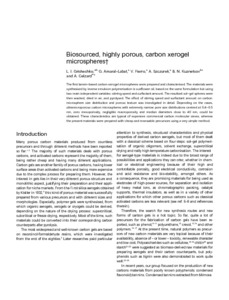Biosourced, highly porous, carbon xerogel microspherest
DOI:
10.1039/c6ra09462gURI (для ссылок/цитирований):
http://pubs.rsc.org/en/content/articlelanding/2016/ra/c6ra09462g#!divAbstracthttps://elib.sfu-kras.ru/handle/2311/69855
Автор:
Grishechko, L. I.
Amaral-Labat, G.
Fierro, V.
Szczurek, A.
Kuznetsov, B. N.
Коллективный автор:
Институт цветных металлов и материаловедения
Кафедра органической и аналитической химии
Дата:
2017-07Журнал:
RSC AdvancesКвартиль журнала в Scopus:
Q1Квартиль журнала в Web of Science:
Q2Библиографическое описание:
Grishechko, L. I. Biosourced, highly porous, carbon xerogel microspherest [Текст] / L. I. Grishechko, G. Amaral-Labat, V. Fierro, A. Szczurek, B. N. Kuznetsov // RSC Advances. — 2017. — Т. 6 (№ 70). — С. 65698-65708Аннотация:
The first tannin-based carbon xerogel microspheres were prepared and characterised. The materials were
synthesised by inverse emulsion polymerisation in sunflower oil, based on the same formulation but using
two main independent variables: stirring speed and surfactant amount. The resultant sol–gel spheres were
then washed, dried in air, and pyrolysed. The effect of stirring speed and surfactant amount on carbon
microsphere size distribution and porous texture was investigated in detail. Depending on the cases,
ultramicroporous carbon microspheres with extremely narrow pore size distributions centred at 0.4–0.5
nm, zero mesoporosity, negligible macroporosity and median diameters close to 40 mm, could be
obtained. These characteristics are typical of expensive commercial carbon molecular sieves, whereas
the present materials were prepared with cheap and renewable precursors using a very simple method.

